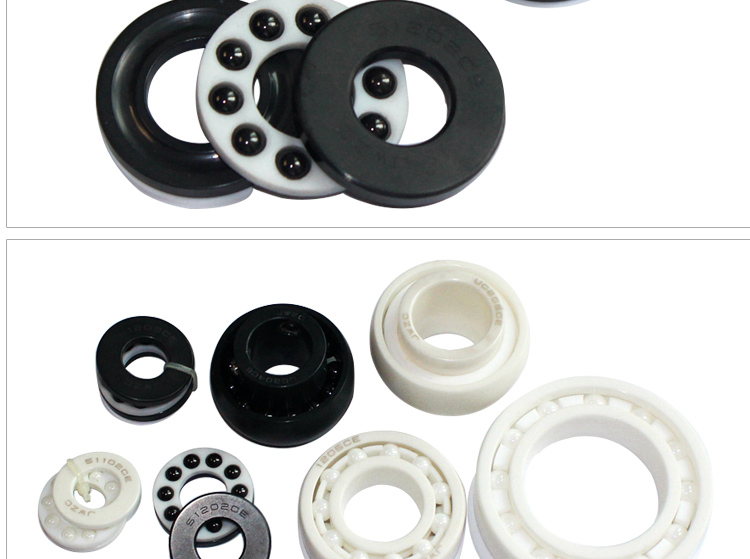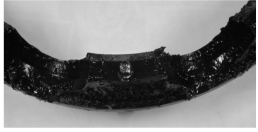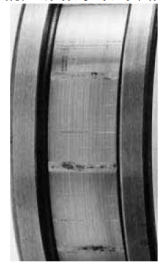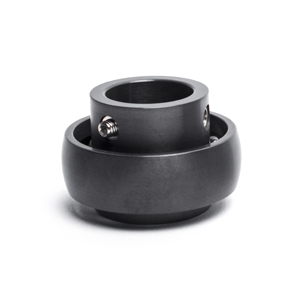Time : Janeiro 5, 2024
Abstract: Premature bearing failures of wind turbine generators are occurring frequently. The reasons are manifold, but based on application studies and bearing investigations two main root causes have been identified: electrical current passage, electrical erosion respectively, due to frequency converter supply of doubly-fed induction generators and lubrication and wear related problems. Strives to give an overview on typical root causes for premature bearing failures in wind turbine generator applications and introduces extra – large (XL) hybrid deep groove ball bearings as a new solution to significantly reduce generator bearing failures and to increase the overall reliability and operating availability of wind turbines.
Key words: wind turbine genera tors; bearings; solution

0 Introduction
The application of power electronic technology in speed control is more and more. This technology replaces many traditional speed regulation methods, such as mechanical gearbox drive, hydraulic drive, etc. The application of frequency converter enables the motor to adjust its speed freely from zero to rated speed and keep it running at a suitable working point, thus improving the efficiency and dynamic response of the motor and reducing energy consumption. The same technology is also used in wind turbines. In the past five or six years, the “doubly fed generator” in large-scale wind turbine equipment has become a typical application and is becoming more and more popular. This technology can enable wind turbines to operate in a relatively wide speed range. In the doubly fed generator, the rotor winding is powered by a frequency converter. The motor can optimize the generation energy and maintain a stable line frequency while changing the rotor speed, while regulating the active power and reactive power. However, due to the introduction of frequency converter system, bearing failure caused by over-current occurs frequently and becomes the main cause of early generator failure. At the same time, it is confirmed that the other main reason for bearing failure is lubrication and corresponding wear.
This paper describes the fundamental causes of early failure of bearings in the application of wind turbines, and introduces the technology of super large hybrid ceramic ball bearings. This technology proposed by can significantly reduce the failure of bearings in generators, and increase the overall reliability and operating stability of equipment.
1 Bearing failure in wind turbine
Bearing is the most important part of various mechanical equipment parts. Bearing failure in the motor may also be caused by many other reasons, such as exceeding the expected load, improper lubrication, improper handling during transportation and shutdown, electrical corrosion, damage caused by installation and disassembly, pollution inside the bearing, seal failure, improper tolerance and fit between the shaft and bearing chamber, etc. Each factor will cause different damage, and at the same time, will leave their own unique traces in the bearing. Through the research of application examples and bearings, it is found that the bearing failures in wind turbines are directly or indirectly related to over-current, lubrication and wear.
1.1 Electric corrosion
In doubly fed generators powered by frequency converters, the problem of current flowing through bearings is very common, which is called electric corrosion. Electrical corrosion of bearings usually occurs when the current flows from one raceway to another through the rolling element. The damage degree of electric corrosion to the bearing depends on the discharge energy and duration, but the damage effect is basically similar, including: small electric corrosion pits on the rolling body and raceway, rapid degradation of lubrication, washboard pattern in the second stage of failure and corresponding bearing failure.
The heat generated during the discharge will cause the bearing material surface to melt and produce pits, and the metal melt chips will be transferred from the original position. The metal on the surface of the etched pits will be re hardened and become more brittle than the previous bearing material. Below the re hardening layer is an annealed layer, which is softer than the surrounding material. The damaged bearing surface looks dark, which is characterized by many melting pits. These tiny pits are all over the rolling element surface and raceway. The size of the pits is very small. Whether on the inner ring, outer ring or rolling element, its diameter is usually only 5-8 μ m。 Therefore, the shape of these pits can only be seen under a very high magnification microscope.
In addition, the current discharge also leads to the deterioration of the internal lubrication of the bearing and rapid degradation. The high temperature makes the additives in the lubricating machine react with the base oil, causing the base oil to burn and carbonize, and the additives will be quickly used up. Therefore, the lubricating machine will become harder or even blacker (Fig. 1), which cannot meet the requirements of lubrication. The rapid failure of the lubricating machine is also a typical failure mode caused by overcurrent.

Fig. 1 Segments of ball bearing cage (lubricating to blackening due to overcurrent)
1.2 Lubrication
An important condition for the stable operation of rolling bearings to reach the service life is to have sufficient lubrication. The role of lubricant is to form a protective oil film, separate rolling contact surfaces, and prevent metal to metal direct contact. The lubricant shall also protect the corresponding parts from corrosion. When lubricating grease is used as lubricant (commonly used in wind turbines), its functions need to be expanded, such as protecting bearings from solid particles, dust and water.
Grease has some important properties, including viscosity, oil film forming ability and density. The most important factors affecting the oil film thickness are the size, speed, temperature, load and viscosity of the base oil of the bearing. In order to obtain some special properties of lubricating grease, some additives are often needed, such as antirust additives to prevent metal rust and oxidation of lubricating grease.
Wind turbines are installed all over the world to withstand different climatic environments and adapt to different environmental changes. For example, the ambient temperature is related to the region, latitude and season of wind turbine installation. Similarly, the humidity of wind fields installed in the North Sea and near the desert will be very different. The lubricant in the wind turbine shall adapt to these changes. Sometimes it is very difficult to accurately predict the parameters under a specific working environment (such as temperature), resulting in poor lubrication performance due to improper selection of grease. Insufficient lubrication will lead to fatigue and wear of metal surface, thus reducing the life of bearing. If the lubricating film between the rolling element and the raceway is too thin, the metal surface will not be fully isolated, and metal to metal direct contact will occur. Such situation may be caused by pollution, insufficient lubrication, etc.
It is very important to supplement lubrication regularly for the bearing to ensure its good operation and reach the expected service life. Generally, in the installed wind turbines, the generator is relubricated manually during routine maintenance. In this process, workers have to climb to the top of the tower every 6 months for work. Sometimes, during routine maintenance, the generator’s re lubrication will be forgotten; Sometimes such time interval is too long for the actual working condition of generator bearing.
1.3 Wear
Generally, there is little wear inside the bearing. When the external particles enter the bearing or the lubrication is insufficient, the wear will occur. During shutdown, the vibration of the bearing may also cause wear.
The application of wind turbine often needs to adapt not only to the harsh environment during operation, but also to the shutdown condition during maintenance. Due to the type, the bearing in the generator is usually an open type deep groove ball bearing. The bearing is protected by an external labyrinth seal. Even so, there is still a risk of contaminants entering the bearing chamber. The most common sources of pollution include: pollution caused by insufficient lubrication (such as dry high-quality particles), damaged seals, environmental pollution particles, and pollution caused by improper installation and replacement of bearing chambers. These pollution particles will lead to fatigue and spalling on the raceway of the bearing after being rolled by the rolling body (Fig. 2).
During transportation, if the rotor shaft of the generator is not fixed properly and the vibration occurs in the bearing clearance, the bearing may be damaged; Similarly, if the generator is in shutdown state, vibration after a period of time will also lead to bearing damage. For the previously designed wind turbine, it still does not stop rotating when it is shut down, which is very common. Therefore, in the updated design, the blade still rotates slowly when it is stopped. However, when the generator is stationary, there is no lubricant between the parts in contact with each other inside the bearing to form an oil film, thus resulting in direct metal contact between the rolling element and the raceway. If the external vibration is introduced again, the vibration will cause very small displacement of the rolling body relative to the raceway. Under such displacement, the small cold welding points and wear between metals will damage the raceway and cause fretting corrosion. Such damage usually occurs at the places where rollers are equally spaced, showing changes in color or gloss. This damage is called “pseudo Brinell indentation” (Fig. 3).

Figure 2 Traces on the surface of the raceway caused by rolling over contaminated particles

Fig. 3 Pseudo Brinell Indentation on Cylindrical Roller Bearing Caused by Shutdown Vibration
2 Mixed ceramic bearing
The hybrid ceramic bearing (Fig. 4) consists of a bearing ring made of bearing steel and a roller made of bearing grade silicon nitride material. Silicon nitride material is a kind of ceramic material, which has many beneficial characteristics: high hardness, electrical insulation, low density and stability; It also has excellent electrical insulation characteristics. The hybrid ceramic bearing has a higher speed capacity and a longer service life than the ordinary all steel bearing under most working conditions.

Fig. 4 Hybrid ceramic bearing composed of bearing rigid ring and bearing grade silicon nitride (ceramic) rolling element
A very important characteristic of silicon nitride material is that it has very good electrical insulation performance. This performance prevents the bearing from being damaged by overcurrent, and increases the service life of the bearing in variable-speed drive motors powered by frequency converters. The density of silicon nitride material is 40% of that of steel material, which makes the rolling element of the bearing lighter and has less inertia. This means that the force on the cage is reduced during fast start and stop, and the bearing friction is reduced compared with the full steel bearing during high-speed operation. Lower friction means lower operating temperature, longer relubrication intervals and lubricant life. Therefore, the hybrid ceramic bearing has better performance at high speed. SKF hybrid ceramic bearing is not very sensitive to insufficient lubrication, which makes it have a longer service life than all steel bearing under more severe dynamic environment or low operating viscosity lubrication conditions.
Compared with steel, silicon nitride material has higher hardness and greater elastic modulus, which increases the robustness of the bearing and extends the operating life of hybrid ceramic bearing in polluted environment. When operating under poor lubrication and harsh environment, the wear resistance of hybrid ceramic bearing is far better than that of all steel bearing. On the other hand, balls made of silicon nitride with the same size have less thermal expansion than those made of steel, which reduces the sensitivity caused by the heat distribution inside the bearing, and makes the preload control more accurate. In order to ensure the optimal quality, SKF uses a set of complex technical requirements for silicon nitride materials for bearing rollers to control the quality. This technical requirement includes material strength, material macrostructure and microstructure, hardness, rigidity, fatigue performance of rolling contact and appearance of finished rolling body surface. Each component of the hybrid ceramic bearing is selected according to the high requirements of the rolling element silicon nitride material.
The characteristics of the hybrid ceramic materials can solve the problems described in the first part of the wind turbine. SKF’s super large hybrid ceramic deep groove ball bearing is a solution that can greatly reduce the premature failure of bearings in wind turbines.
3 Super large hybrid ceramic deep groove ball bearing
From a technical point of view, hybrid ceramic bearings are the most reliable solution for wind turbine applications. Because it not only has a very good electrical insulation material, which can completely eliminate the high-frequency current flowing through the bearing, but also has excellent tribological performance under severe operating conditions.
SKF has developed a series of super large hybrid ceramic deep groove ball bearings (see Table 1). This series of products optimizes the product performance for the application of wind turbines, covering the main models in mainstream wind farms.
In the traditional design, two deep groove ball bearings of the same model are placed in the drive section and non drive end of the wind turbine. In order to avoid over-current and solve the problem of electric corrosion, it is recommended to use super large hybrid ceramic deep groove ball bearing to replace all steel deep groove ball bearing in the bearing of doubly fed generator. This can solve the wear caused by poor lubrication and pollution, and improve the operation reliability.
It is very simple to replace the existing deep groove ball bearing with SKF super large hybrid ceramic deep groove ball bearing. According to the requirements of ISO 15: 1998, this kind of bearing has the same overall dimensions as ordinary bearings. It does not need to redesign the external parts of the bearing or install them with special tools, as long as it is disposed in the same way as ordinary bearings.
4 Conclusion
Due to the special design of doubly fed wind turbine and the introduction of frequency converter, high-frequency stray bearing over-current is very easy to occur. Therefore, electric erosion and early failure of bearings also often occur, which requires electrical insulation on bearings at both ends. In addition to electrical corrosion, insufficient lubrication and wear have also become an important reason for wind turbine failures. By using SKF insulated hybrid ceramic bearings, it is possible to prevent the current from passing through the rolling contact part of the generator bearing. Due to the use of superior materials and quality control, SKF hybrid ceramic bearings have better technical reliability and more economic long-term cost efficiency for premature failure of bearings due to stray current and poor lubrication. The operational reliability and availability of wind turbines have been improved, and the cost per kilowatt has been reduced. The hybrid ceramic deep groove ball bearing has standard dimensions, and can be replaced with the full steel deep groove ball bearing of the same size without special tools and additional work.
2024 January 1st Week XZBRG Product Recommendation:
Rolamentos de pastilha de cerâmica completos:
Rolamentos de pastilha de cerâmica tem resistência a altas temperaturas, resistência ao frio, resistência ao desgaste, resistência à corrosão, sem isolamento de magnetoeletricidade, autolubrificação livre de óleo, características de alta velocidade, pode ser usado em condições ambientais extremas e condições especiais.
Configuration:
https://www.xzballbearing.com/product/ceramic-insert-bearings/
